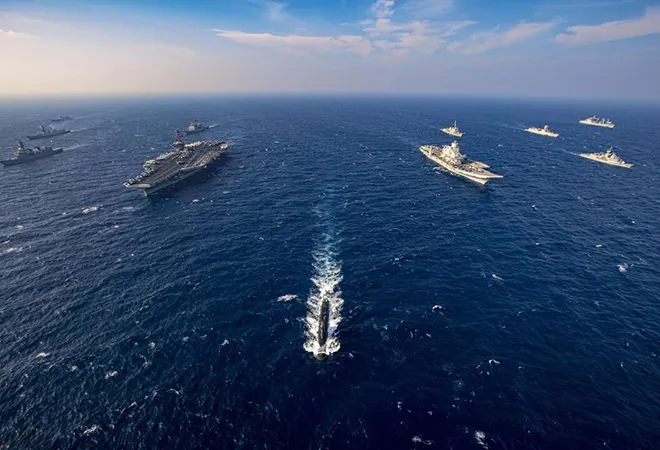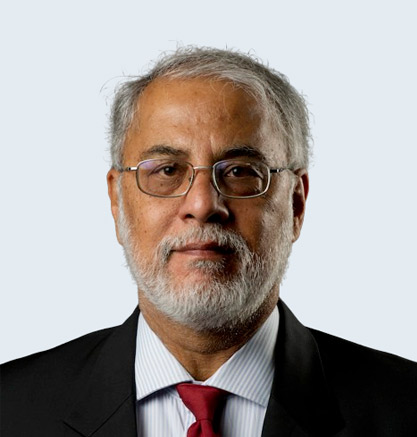-
CENTRES
Progammes & Centres
Location
For now, India’s role in the Western Pacific region remains symbolic, and in the Indo-Pacific context, confined to the Indian Ocean Region.

The notion of the Indo-Pacific has recently become widely used, particularly in the United States, India, Japan, and Australia, and has almost replaced the earlier term “Asia-Pacific.” In Russia, this change of geopolitical terminology is usually seen through the prism of the U.S.-China confrontation and Washington’s determination to strengthen America’s position in that part of the world by engaging India on its side. Yet India is developing its own conceptual constructs, which may carry the same name, but are based on New Delhi’s view of the world and national interests.
The term “Asia-Pacific,” which was first coined in the United States, excluded South Asia. The Asia-Pacific Economic Cooperation (APEC), which staged high-profile annual summits from the 1990s through the 2010s, does not include India as a full member. As for India itself, following the end of the Cold War, it began to come up with new geopolitical concepts that reflected the dramatically changed international environment.
The diplomatic and economic facet of New Delhi’s strategy began with the “Look East” policy of the P. V. Narasimha Rao government in 1991: an effort to cultivate economic and strategic relations with Southeast Asia, in a marked shift in India’s global outlook following the Cold War. It was also seen as an important component of India’s decision to open up its economy and take advantage of the dynamic East Asia region.
India’s strategic thinking was shaped by the fact that it has serious disputes with Pakistan to its west and China to the north, which limits its overland communications and trade with those regions. So on the one hand, India looked eastward, and on the other, toward the Indian Ocean.
India’s strategic thinking was shaped by the fact that it has serious disputes with Pakistan to its west and China to the north, which limits its overland communications and trade with those regions. So on the one hand, India looked eastward, and on the other, toward the Indian Ocean.
The foundations of India’s current Indo-Pacific policy were laid at the turn of the twenty-first century. In the aftermath of the 1998 Indian nuclear tests, the United States began a policy of rapprochement with India, which led to closer Indo-U.S. ties.
The next stage in Indo-U.S. interaction occurred in the wake of the devastating tsunami of December 26, 2004, which killed some 225,000 people in Indonesia, Sri Lanka, Thailand, and India. At the initiative of then U.S. president George W. Bush, the United States, Australia, India, and Japan formed a coalition to provide immediate assistance to those affected. Although the coalition lasted merely a week, it formed the basis of the notion of a quadrilateral grouping: the Quad. A proposal to formalize the group was put forward by Japanese Prime Minister Shinzo Abe in 2006, but came to nothing.
Since then, the steep rise of China and its increasing assertiveness—evidenced by developments in the East and South China seas, as well as the growing importance of the Asia-Pacific region as a whole—have triggered a number of policy moves by various countries. To balance China’s growing might and its expanding influence, Washington and Tokyo began to work to bring New Delhi into the strategic equation. To achieve that, they modified their strategic concepts around the notion of the “Indo-Pacific.”
True, India is not a significant economic or military player east of the Malacca Straits. But to the west of the straits, its geography makes it a major anchor for any strategy that links the Pacific with the Indian Ocean. India shares maritime and land borders with four out of the ten ASEAN states. Jutting out 2,000 kilometers into the Indian Ocean, India also sits astride key sea lanes and dominates the western end of the Malacca Straits.
ASEAN countries themselves remained ambivalent: they welcomed the U.S. presence in the region, but since they also enjoy close economic ties to China, they refused to participate in any confrontation with Beijing. The ASEAN reluctance to directly involve itself in the U.S. Indo-Pacific strategy pushed Washington to take another course. In 2017, as U.S.-Chinese rivalry escalated into confrontation, President Donald Trump’s administration dusted off the old Quad format to serve as an instrument of its Indo-Pacific strategy to check China. Trump’s successor Joe Biden regards China as the main challenger to U.S. global primacy, and is busy building a “coalition of democracies” aimed at outcompeting China on a wide range of issues, mainly economic.
The Quad grouping, however, remains an instrument of any U.S. Indo-Pacific strategy. The goal of that strategy, as articulated in a declassified U.S. government document at the beginning of 2021, is “maintaining U.S. strategic primacy” in the region. For that, Washington needs a credible democratic partner on the Asian continent and in the Indian Ocean area. With that in mind, the United States is willing “to accelerate India’s rise and capacity.”
New Delhi may, of course, have a different point of view, and is not committed to these goals. Unlike the other Quad nations, it does not have any formal military ties to the United States. But India will not hesitate to take advantage of the grouping to enhance its own political and economic profile in the region.
New Delhi may, of course, have a different point of view, and is not committed to these goals. Unlike the other Quad nations, it does not have any formal military ties to the United States. But India will not hesitate to take advantage of the grouping to enhance its own political and economic profile in the region.
Even though there is a great deal of activity around the Quad, it is clear that New Delhi is in no position to play a significant military role outside its neighborhood. Confronting China somewhere in the Western Pacific, 5,000 kilometers away, is not credible when the Chinese are sitting along a large chunk of India’s land borders. In any case, India lags behind China in almost all elements of comprehensive national power, including its military. East of Malacca, India can at best play a symbolic role as an ally of the United States and Japan, and seek a payoff in pushing its own economic growth agenda amid the U.S.-Chinese estrangement. It could play a strong security role west of the Malacca straits in the Indian Ocean, where it has considerable natural advantages.
India recognizes the centrality of ASEAN to its Indo-Pacific strategy, but in the region, its key political and economic ties remain anchored in the city-state of Singapore. It has failed to build significant ties with other ASEAN states, even Vietnam, with which it had long had an important relationship. In that sense, it is unable to play a larger role of counterbalancing Chinese power in the region. As of now, India’s role in the Western Pacific region remains symbolic, and in the Indo-Pacific context, confined to the “Indo,” or the Indian Ocean Region (IOR). Even here it is feeling the pressure from China, which has made significant inroads into South Asia and the IOR. India’s neighbors, such as Nepal, Bangladesh, Pakistan, Sri Lanka, and Myanmar have developed strong ties with Beijing, which has already developed substantial trading links with the IOR as a whole.
India’s future ambitions depend on the trajectory of its economy. By opting out of the Regional Comprehensive Economic Partnership free trade agreement, New Delhi has forfeited an opportunity to participate in a vital new economic grouping that could have added zest to its Indo-Pacific strategy. This has already begun limiting its naval ambitions and the ability to play the role into which many expect the Quad is hoping to evolve: that of an informal military alliance or pressure group.
This commentary originally appeared in Carnegie Moscow Center.
The views expressed above belong to the author(s). ORF research and analyses now available on Telegram! Click here to access our curated content — blogs, longforms and interviews.

Manoj Joshi is a Distinguished Fellow at the ORF. He has been a journalist specialising on national and international politics and is a commentator and ...
Read More +